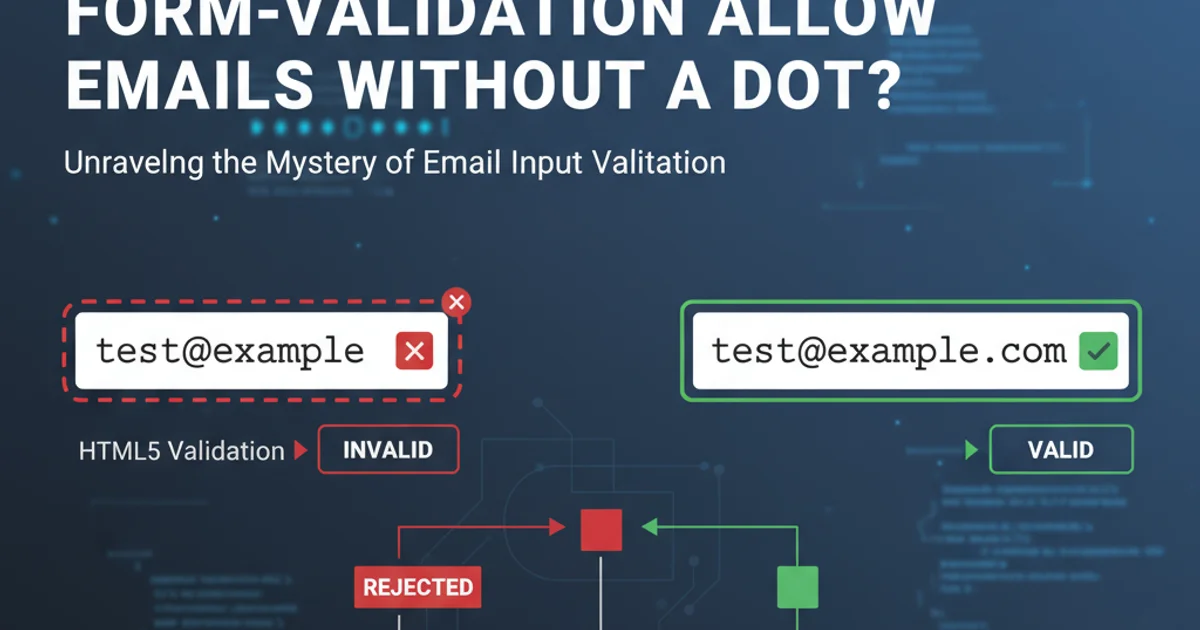Why does HTML5 form-validation allow emails without a dot?
Categories:
Understanding HTML5 Email Validation: Why 'user@localhost' is Valid

Explore the nuances of HTML5's built-in email validation, why it allows addresses without a dot, and how to implement more robust server-side checks.
When developing web forms, the type="email" attribute in HTML5 provides a convenient first line of defense for validating user input. It automatically checks if the entered text looks like an email address. However, many developers are surprised to find that addresses like user@localhost or test@example pass this client-side validation, despite not conforming to common expectations of a 'real' email address (i.e., one with a dot in the domain name). This article delves into the reasons behind this behavior and offers solutions for more stringent validation.
The HTML5 type="email" Specification
The HTML5 specification for type="email" is intentionally broad. Its primary goal is to ensure that the input value is a syntactically valid email address according to the RFCs (Request for Comments) that define email formats. Specifically, it largely adheres to RFC 5322 and RFC 6531 (for internationalized email addresses). These RFCs permit a wide range of characters and structures, including domain names without a dot, as long as they are valid hostnames. For instance, localhost is a perfectly valid hostname, and thus user@localhost is a syntactically correct email address.
flowchart TD
A["User Enters Email"] --> B{"HTML5 type='email' validation"}
B -->|Syntactically Valid (e.g., user@localhost)| C["Passes Client-Side Validation"]
B -->|Syntactically Invalid (e.g., user@)| D["Fails Client-Side Validation"]
C --> E["Form Submission"]
E --> F["Server-Side Validation (Recommended)"]
F -->|Passes Strict Rules| G["Data Processed"]
F -->|Fails Strict Rules| H["Error to User"]HTML5 Email Validation Flow
The rationale behind this lenient approach is to avoid overly restrictive client-side validation that might reject legitimate, albeit uncommon, email formats. The HTML specification prioritizes usability and broad compatibility, leaving more specific business rule validation to the server-side. This prevents frustrating users with errors for technically valid inputs, while still providing a basic level of input sanitation.
Why a Dot is Not Required by RFCs
Email addresses are composed of a local part and a domain part, separated by an @ symbol. The domain part must be a valid hostname or an IP address literal. Hostnames, as defined by RFCs like RFC 1035, can be single-label (e.g., localhost) or multi-label (e.g., example.com). A single-label hostname does not contain a dot. Therefore, an email address like user@singlelabelhost is technically valid according to the underlying specifications that HTML5 aims to follow.
user@localhost is syntactically valid, it's typically not a deliverable email address on the public internet. It's often used for local testing or internal network communication.Implementing Stricter Validation
Since HTML5's type="email" is a basic check, you'll almost always need more robust validation, especially for public-facing applications. This should primarily be done on the server-side, but you can also enhance client-side validation for a better user experience.
Client-Side Enhancement with pattern
You can use the pattern attribute with a regular expression to enforce stricter rules on the client-side. This pattern will be checked in addition to the browser's default type="email" validation. A common pattern to require a dot in the domain is shown below:
<input type="email" id="email" name="email"
pattern="^[a-zA-Z0-9._%+-]+@[a-zA-Z0-9.-]+\.[a-zA-Z]{2,}$"
title="Please enter a valid email address (e.g., user@example.com)">
HTML input with a stricter email pattern
pattern attribute is best for common, simple enhancements.Server-Side Validation (Essential)
Server-side validation is crucial because client-side checks can be bypassed. Most programming languages offer robust libraries or built-in functions for email validation. These often go beyond simple regex to check for domain existence (via DNS lookups) or disposable email addresses.
import re
def is_valid_email(email):
# A more robust regex for server-side, still not perfect but better than HTML5 default
# This example requires a dot in the domain and a TLD of at least 2 characters
pattern = r"^[a-zA-Z0-9._%+-]+@[a-zA-Z0-9.-]+\.[a-zA-Z]{2,}$";
if re.match(pattern, email):
return True
return False
print(is_valid_email("user@example.com")) # True
print(is_valid_email("user@localhost")) # False with this pattern
print(is_valid_email("invalid-email")) # False
Python example for server-side email validation